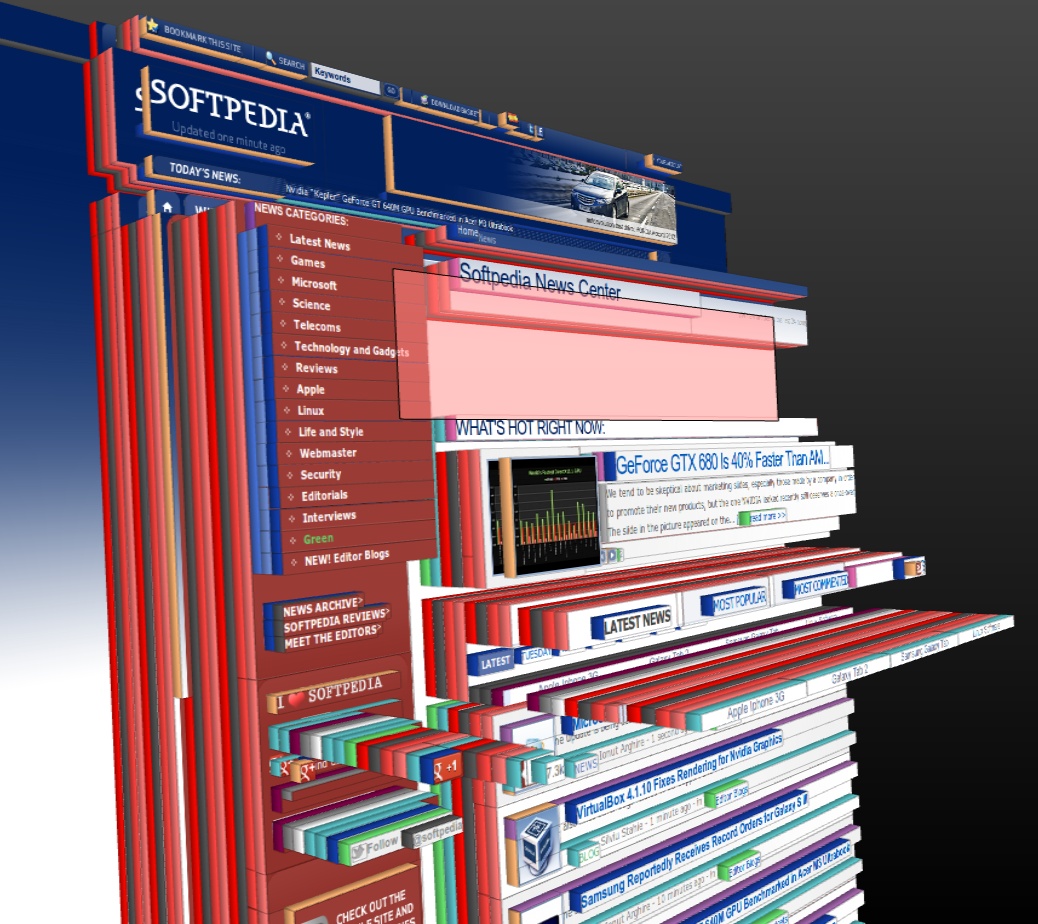In 2007 the team at Mozilla, who produce FireFox, jumped into the 3D graphic realm by offering a plug-in that could show 3D graphics within the browser.
This plug-in, which is still popular, was called the 3D Tab Effect, would animate the change to another browser tab with a 3D graphic of a block turning.
The company would jump into this technology again a couple years later with a plug-in called FireHawk 3D 1.6 that offered a 3D browsing experience, but it may not have been as immersive or 3D as users had hoped.
No Plug-In Required
This past week, IDG News Service reported that a group of researchers has delved into 3D technology with FireFox as its conduit. The new technology is designed to be used without a plug-in and will feature a multi-user capability. This technology was announced and previewed at the Cebit Tradeshow in Hannover, Germany.
According to the release, Philipp Slusallek, a professor at Saarland University and head of the research department Agents and Simulated Reality at DFKI (the German Research Center for Artificial Intelligence) noted that:
“There are two ways to generate a three-dimensional image for a two-dimensional screen: rasterization and real-time ray tracing. What the researchers have done is developed faster software for performing real-time ray tracing, which is also aided by today’s faster processors.”
Adding the 3rd Dimension
The name of this technology is RT Fact, and it was developed by the German Research Center for Artificial Intelligence and the Intel Visual Computing Institute at Saarland University in Germany. The researchers have worked it into the rendering engine for browsers such as Firefox, Safari, and Chrome called Webkit.
Using this universal browsing engine, the images put in then utilize XML3D, part of the HTML web programming language, and the browser can actually render the 3D scene itself. The professor noted that with this technology, anyone with a basic knowledge of HTML could, in fact, use this method to their benefit. This could lead to millions of people creating their own 3D environments online, opening up huge possibilities for revenue.
The reveal concluded with a demonstration of the technology that consisted of a virtual tour of Venice, Italy. Slusallek pulled up a Wikipedia entry on Venice with a 3D graphic of one of the city’s palaces. “You can stand on the balcony and actually look at Venice from the top floor,” Slusallek said.
The Next Step
The researchers are planning on introducing a version of Firefox with RT Fact in the near future, but they have to go over the plan with Mozilla to see if they can call the browser Firefox. The modified browser is expected to emerge in a couple weeks.
The researchers are hoping that the World Wide Web Consortium (W3C), the group that creates Web standards, will accept the technology so other software vendors can also incorporate the technology in their respective browsers.
The Potential of 3D
It’s thrilling to think that we’re nearing the edge of the 2D realm online. The internet is such a multipurpose device, that the addition of another dimension of viewing seems only logical. But will this push to create an online world that’s in 3D be similar to previous pushes toward this entertaining medium like in previous decades, or will this venture be as profitable as Avatar?
Steve Wu, a lawyer for Cooke Kobrick & Wu LLP that works with 3D internet law, noted the importance of Avatar for the push toward 3D internet. He states that after seeing the film he:
“now realizes that not only will people want 3D technology to see existing 3D Internet spaces in 3D, it will drive people to demand that providers of 2D content create new 3D Internet applications.
I see the Avatar film as accelerating the adoption of the 3D Internet. 3D viewing will drive interest in 3D online spaces. And 3D online spaces will become viewable in 3D and drive interest in viewing content in 3D. The two trends will feed each other, and our entertainment choices will be richer for it. Of course, more legal issues are sure to follow.”
The Meeting of the Minds
Of course, Avatar creator James Cameron wasn’t the first person to see the future in 3D. Developer Intel saw the impending need for 3D content before the film even hit theaters. In fact, Intel even acquired DFKI last year, and opened the Intel Visual Computing Institute for developing the technology further.
The CEO of DFKI, Professor Dr. Wolfgang Wahlster, noted “Joint areas of interests between DFKI and Intel are visualization and especially the 3D-internet of the future, where 3-dimensional worlds can be experienced.”
During this merger, one of the initiators of the Intel Visual Computing Institute, Slusallek, chimed in and said, “Together with Intel, DFKI wants to further explore the basic technologies for the 3D-internet, additionally dynamizing the development in Information Technology.”
3D Goes Mainstream, Again
It seems like a lot of the building blocks are already in place to make this 3D online world a reality, but how will this technology really work? It’s important to note that this technology is developed to work for 2D screens but it’s inevitable that a 3D screen will be developed.
Will users be required to buy new monitors that have 3D capability built in when this stage is reached? 3D films use special technologies in the film itself as well as the projector; even the screen material is different.
So how will this move towards 3D be economical? A look at the push towards 3D television would make one believe that buying a whole new setup is the only answer, with manufacturers putting out 3D-capable sets that will be able to handle the 3D content that networks like ESPN are developing.
Overall, this push towards 3D internet is exciting and opens a Pandora’s box of possibilities, but this technology needs to be introduced to the masses properly or it will end up simulating the 1980’s where the masses flocked to see Michael Jackson’s 3D adventure, “Captain EO” before the technology faded into back into fad territory.
If anything, Avatar did prove that the technology is ready for 3D to become a reality instead of a fad, but unless developers and researchers can make it inexpensive to consumers, it will never catch on as fast as Facebook.






GIPHY App Key not set. Please check settings